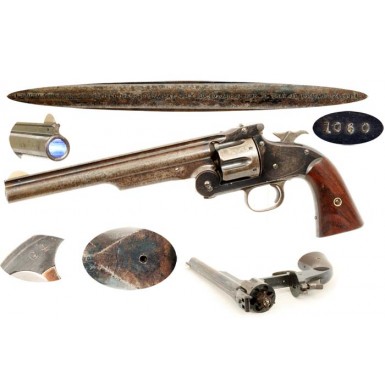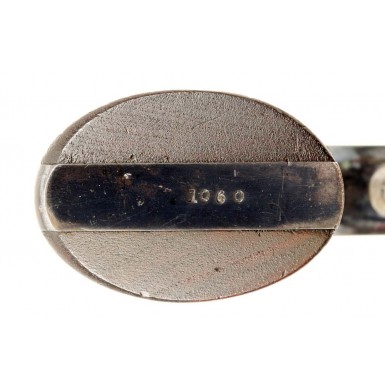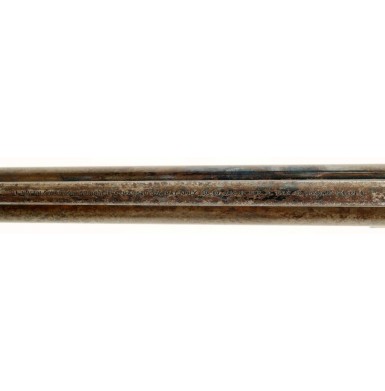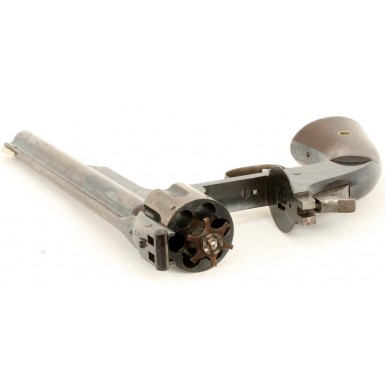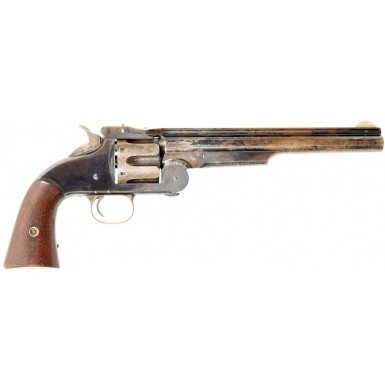1st Model Smith & Wesson #3 American - Oil Hole
- Product Code: FHG-1798-SOLD
- Availability: Out Of Stock
-
$1.00
In 1870, Smith & Wesson introduced a new cartridge revolver that would become the basis for at least five other models, and that would remain in production in one form or another for four decades. The Model # 3 First Model, which eventually received the moniker “American” some time in 1872 after a major contract was signed to provide revolvers of the #3 pattern to the Russian military, was the prototypical large frame Smith & Wesson handgun of the old west period. The revolver was chambered for the .44 S&W American cartridge (less than 100 were also manufactured in .44 Henry Rim Fire), which was simply called the .44-100 when it was first introduced, but which had to be differentiated from the “Russian” variant of the .44 cartridge after that contract was signed. The gun was a single action revolver with a six shot cylinder and a ribbed, 8” round barrel. The revolver incorporated a number of “firsts’ for the company, as it was the first center fire revolver that Smith & Wesson produced. It was also the first .44 caliber handgun, the first “large frame” handgun and most importantly the first gun to feature a tip down barrel with simultaneous extraction. The revolver was originally designed for the 1870 US Ordnance Board handgun trials, and performed well enough that a contract for 1,000 guns were received by the company in December of 1870, with the deliveries made in March of 1871. These “martial” #3 Americans appear to be somewhat evenly distributed within the serial range of 125 to 2199. One of the features that made the #3 so appealing was the “simultaneous’ extraction system. By lifting a latch on the top of the frame the action of the revolver was opened and as the barrel was tipped down, a star extractor, powered by a ratchet mechanism, withdrew the cartridges from the cylinder, and expelled the empty cases. It was then an easy matter to replace any spent rounds, close the action and be ready to use the revolver again. By comparison, Colt’s competing design, the Single Action Army, released in 1873, required a slow system of manual extraction of each spent case one at a time, with an equally slow loading process. The simultaneous extraction system would be so successful and popular that a number of Smith & Wesson models in multiple frame sizes and calibers would utilize it, well into the 20th century. The first 1,500 or so of the #3 American revolvers were manufactured with a tiny “oil hole” in the bottom of the barrel web, just in front of the frame hinge and ratchet system. This allowed for the ratchet mechanism to be lubricated. It was discovered that this was an unnecessary feature and was eliminated somewhere between serial numbers 1450 and 1537. In all, Smith & Wesson would produce about 8,000 Model # 3 “American” First Model revolvers between 1870 and 1872, when a refined version the “Second Model American” would replace it. Many of the small design changes and improvements can be credited to changes requested by the Russian government, who had ordered some 20,000 #3 Revolvers in 1871. The initial successes of the #3 made the gun very popular in a number of circles. Major George W. Schofield of the 10th US Cavalry, one of the famous regiments of “Buffalo Soldiers’ was one of those people who had a great fondness for the Smith & Wesson design. In fact Schofield was so impressed with the design that he arranged to act as a sales agent for Smith & Wesson. Schofield sold over 100 Smith & Wesson #3 American revolvers between the fall of 1870 and spring of 1871. Most of those guns were almost certainly sold to other cavalry officers, and as a result Schofield started to build a foundation of support for the Smith & Wesson design. Schofield suggested a number of improvements to make the revolver more user friendly for the cavalry, and the end results were the 1st Model Schofield and later the 2nd Model Schofield, both of which were modified #3 American’s, chambered for the .45 S&W cartridge. Other western luminaries were very fond of the Smith & Wesson design, including William F. “Buffalo Bill” Cody and frontier lawman Wyatt Earp, who supposedly carried a #3 at the famous shootout at the “O.K. Corral”. Over the next four decades thousands of #3 variants would be produced, in a variety of calibers and some even fitted with shoulder stocks and long barrels as revolving rifles. The success of the design was resounding, and in the end the average frontiersman was about as likely to have a Smith & Wesson #3 (or some variant there of) in his holster as a Colt Single Action Army. All of that, however, started with the Smith & Wesson Model #3 1st Model American Oil Hole Revolver in 1870.
Offered here is a VERY FINE condition example of a Smith & Wesson Model #3 1st Model American Oil Hole Revolver. The gun is 100% complete and correct in every way and remains an extremely crisp, unaltered example of a very early large frame .44 Smith & Wesson. The revolver is serial number 1060, and that number is clearly stamped in the butt of the revolver. The serial number is also clearly stamped on the inside the right grip panel. Interestingly serial numbers 1059 and 1061 are listed in the Springfield Research Service Serial Number Books as being delivered to the US Army as part of the 1000 #3 First Model American revolvers that they ordered in 1870, with delivery taking place in March of 1871. It is amazing that this revolver somehow escaped being sold to the US military, and it is probably because of that twist of fate that it remains in such wonderful condition. The alphanumeric assembly mark C4 is found on the grip frame under the right grip panel, on the rear face of the cylinder and on latch that opens the action. The top of the 8” ribbed barrel is roll marked in a single line: SMITH & WESSON SPRINGFIELD MASS U.S.A. PAT. JULY 10. 60. JAN. 17. FEB. 17. JULY 11. 65 & AUG. 24. 69. The marking is flanked by a pair o Maltese Crosses, one at each end. The gun feature the very desirable, early production “oil hole” in the bottom of the barrel web, just in front of the barrel hinge. Only the first 1,500 New Model #3 American revolvers had this feature. This gun would have been produced about 2/3 of the way through the production run of these early first variant, “oil hole”, revolvers. The pistol is really in VERY FINE condition. The frame retains about 80%+ of its original bright blue overall, showing some minor flaking, toning and fading from typical use. The right side of the frame retains slightly more of the original finish than the left. This is probably the result of the revolver being stored long term on its left side, resulting in some finish wear and erosion. Even the backstrap and gripstrap retain large amount of bright, original Smith & Wesson blue. The barrel retains about 30%+ of its original blue overall, which is most prevalent in the groove between the barrel and the rib, along the bottom of the barrel and around the web and lug. The right side of the barrel retains about 40% of its blue, with the left side retaining about 20% of its blue. The right side retains large amounts of streaky original blue over a muted blue-gray patina, while the left side has a more mottle appearance (more evidence of being stored on a cloth on that side) with a similar blue-gray patina, but less blue remaining. Overall, the gun retains about 60%+ original blue, averaged across the entire gun. The areas of finish loss have a pewter undertone with as smoky bluish-gray patina. The frame is mostly smooth with only some lightly scattered traces of pinpricking present. There are also a couple of tiny patches of light surface oxidation on both sides of the frame, behind the recoil shield. The grip strap also shows some lightly scattered pinpricking and flecks of minor surface oxidation. The barrel shows slightly more pinpricking than the frame, with some very light pitting present around the muzzle. The cylinder shows a similar surface patina as the barrel, with a slightly more even dulled and faded blue on the cylinder proper and more bright blue remaining in the flutes. The cylinder probably retains about 25%+ of its original finish, with most of the bright blue in the cylinder flutes. The cylinder is mostly smooth with some very small, scattered patches of light pinpricking present. There are some small flecks of minor surface oxidation scattered along the entire gun with the tiny oxidized freckles appearing in the original blue. The bore of the revolver is in about VERY FINE condition as well, and remains extremely bright with crisp rifling that shows only some very lightly scattered pinpricking and frosting in the grooves along its length. The hammer retains about 40%+ mottled case coloring, which has faded and dulled to a smoky tobacco brown base color with darker case hardened mottling still visible, along with some flecks of minor surface oxidation. The hammer spur retains fine, sharp checkering. The triggerguard retains about 10%-15% of its mottled case coloring, which is confined to the protected areas in the webs at the front and rear of the triggerguard. The balance of the triggerguard is a smoky tobacco brown patina like the hammer, with some of case colored mottling present. The trigger retains about 70%+ original blue, with the expected fading and light wear on the face and silvering on the edges and contact points. The screws all retain at least some minor traces of their pale niter blued finish; with some retaining as much as about 30% of their original finish. All of the screw heads are in very good condition, with only a couple showing some light slot wear, and the balance appearing quite crisp and relatively untouched. The original small rear sight is in place on the top of the frame latch, and the original German silver front sight is correctly pinned into the barrel rib near the muzzle. The revolver is mechanically EXCELLENT and functions correctly in every way. The action performs crisply and the gun remains extremely tight with flawless indexing and lock up. The automatic extraction system functions smoothly and correctly as well. The revolver locks up very tightly and the frame to barrel fit is excellent with no wobble or looseness. The two-piece walnut grips rate about VERY FINE to NEAR EXCELLENT. They both are solid and complete with no breaks, cracks, chips or repairs. As noted the right grip panel is correctly stamp-numbered to the revolver on its interior. The grips are extremely sharp with excellent edges and nearly all of their original oiled finish present. Even the sharp leading and trailing edges at the bottoms of the grip panels retain wonderful edges with almost no noticeable wear. The grips do show a very few light bumps and dings from handling, use and storage, but remain in truly fantastic condition.
Overall this is a really wonderful, VERY FINE condition and very scarce example of a Smith & Wesson Model #3 1st Model American Oil Hole Revolver. These early production #3s are extremely desirable and are rarely found in this condition. Many of the guns in this serial number range were part of the 1,000 revolvers purchased by the US Army in 1870 and saw heavy use in the field. The end result is that it is very difficult to find one of these early “oil hole” guns in such wonderfully sharp condition with so much original finish. The gun is absolutely 100% complete and correct in every way, displays wonderfully, and is mechanically excellent. This is a wonderful piece of American western heritage and history and for an advanced Smith & Wesson collector this is one of those scarce guns, rarely found in this condition that will be a centerpiece in their collection. It will likely be a long time before you get another chance to buy a Smith & Wesson New Model #3 American Oil Hole Revolver with this much original finish on it.

